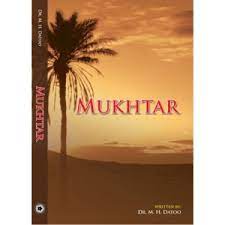Mukhtar - How He Avenged the Karbala Perpetrators
 | |
| Author | Mahmood Husein Datoo |
|---|---|
| Language | English |
| Published | 2012 |
| Publisher | The World Federation of KSIMC |
| Pages | 130 |
The book Mukhtar - How He Avenged the Karbala Perpetrators summarizes the historical process of the Karbala incident and how Mukhtar took revenge.
About the author[edit | edit source]
Dr Mahmood Datoo is an Associate Professor in the School of Built Environment and Architecture. He is currently the Interim Director of Education and Student Experience. He has over 30 years of experience in teaching Structural Analysis, Stress Analysis and Finite Element Modelling. He has authored a book on “Mechanics of Fibrous Composites”. He teaches undergraduates and postgraduates in Structural Analysis and Finite Element Modelling. Dr Datoo's research interests include the structural, stress analysis and finite element modelling of thin-walled structures. He is also interested in stress analysis of advanced composites. He has a keen interest in Islamic history, specialising in the period of Prophet Muhammad’s lifetime, and fifty years on (570-680 AD). He lectures at Islamic Centres, mostly in the UK and USA, and has authored three books on the subject.
About the book[edit | edit source]
This book published in The World Federation of KSIMC; Numbered edition (3 Aug. 2012), has 130 pages and is written in a narrative, story-like form that makes it enjoyable to read.
Abstract of chapters[edit | edit source]
The book is divided into 26 chapters. The first one is about Mukhtar and his life.
In the following, the author examines the story of Mukhtar's first imprisonment and after that, his acquaintance with Kumayl Hamadani and the events that took place through this.
After Mukhtar's release and the rampage in Medina over the death of Yazid, Mukhtar sought permission and blessings for the mission from the Imam of the time, Imam Zainul Abideen, and started his activities.
A group of sixteen thousand became to be known as the Tawwabun (The Penitents), the people who felt sorry, was created. Sulayman Surad Khuzai was chose to be the leader of the Tawwabun. This group were fully aware that many of the Karbala’s killers were in Kufa, but the strategy was to go first after the main architect of the Karbala tragedy, that was Ubaydallah Ziyad.
With Obaidullah Ziad’s fleeing from Basra to Damascus, the mission of the Tawwabun group begins but Mukhtar get arrested for the second time.
Mukhtar teams with Ibrahim Malik Ashtar and become the governor of Kufa rules over there.
The main mission starts and Mukhtar goes after the perpetrators of Karbala.
Mukhtar fought to the last and was finally killed by the enemies and was buried behind Muslim Aqeel near the Kufa Mosque and the pilgrims go there for pilgrimage.
Mukhtar continues to fight until he is the last one from his side, when he is finally set upon and has his head cut; the date was 14 Ramadhan 67AH (Mukhtar became the governor of Kufa, with the aim to avenge theKerbala perpetrators on 14Rabil Awwal 66 AH).
An old man at the courtyard in Kufa, who witnessed the going-ons , said: in this very court yard in Kufa, I saw ImamHusein's (as) head beforeUbaydallah Ziyad, the head ofUbaydallah Ziyad before Mukhtar, the head of Mukhtar beforeMasa'b Zobayr , and now the head ofMasa'b Zobayr before Abdul Malik; on hearing this, Abdul Malik regards the courtyard in the palace as a bad omen and orders that the governor's palace be burnt down.
final lines of the book